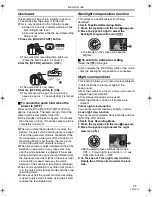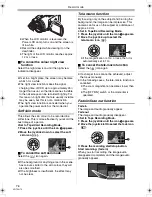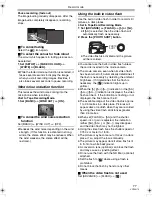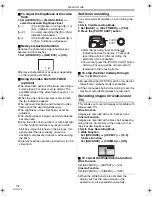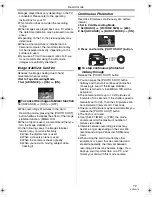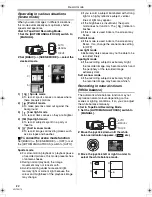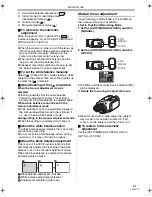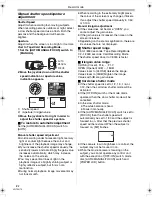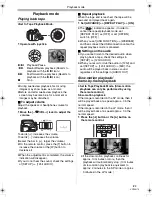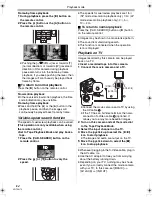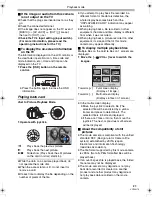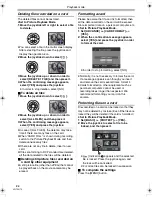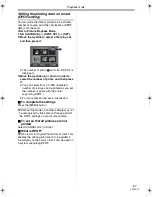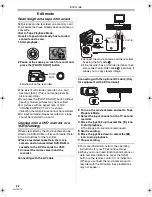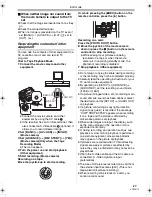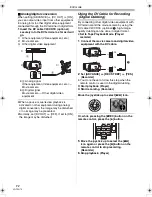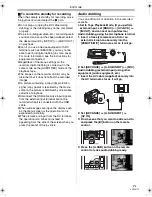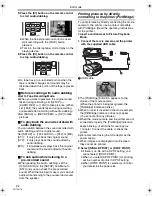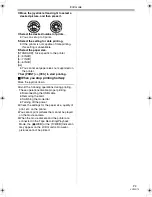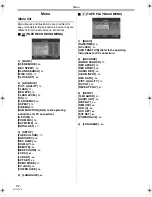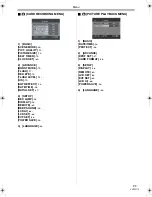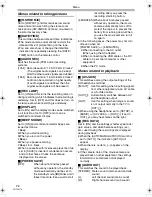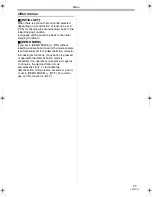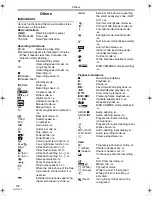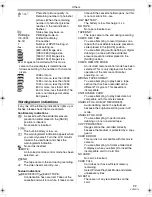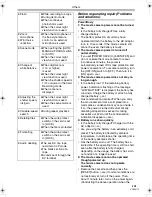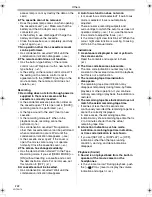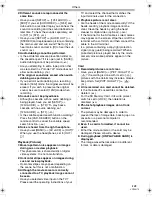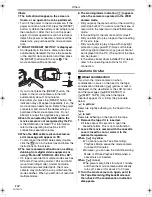
Edit mode
89
VQT0N70
ª
When neither image nor sound from
the movie camera is output to the TV
set
≥
Check that the plugs are inserted as far as they
go.
≥
Check the connected terminal.
≥
When no image is presented on the TV even if
set [BASIC] >> [AV JACK] >> [OUT/
Ë
], set to
[OUT]. (
-96-
)
Recording the contents of other
equipment
You can dub the contents of other equipment to a
DV cassette or card, and can record TV
programs.
≥
Set to Tape Playback Mode.
1
Connect the movie camera and other
equipment.
≥
Connect the movie camera and other
equipment by using the
AV cable
1
.
≥
If the recorder has an S-Video terminal, then
also connect an S-Video cable
2
(optional). It
allows you to record clearer image.
2
Set [BASIC] >> [AV JACK] >> [IN/OUT].
(Movie camera)
3
Set [ADVANCE] >> [REC STDBY] >> [YES].
(Movie camera)(Only when the Tape
Recording Mode)
≥
The icon appears.
4
Turn the power on and start playback.
(Other equipment)
5
Start recording. (Movie camera)
Recording on a tape:
Move the joystick up to start recording.
Or, while pressing the [
¥
REC] button on the
remote controller, press the [
1
] button.
Recording on a card:
Press the [PHOTO SHOT] button.
6
Move the joystick of the movie camera
down or press the [
∫
] button on the remote
controller to stop recording.
≥
While analog input pictures are being
recorded on a tape or when the movie
camera is in recording standby mode, the
photoshot recording is disabled.
7
Stop playback. (Other equipment)
≥
Do not plug or unplug the cable during recording
or the recording may not be completed properly.
≥
Carefully read the operating instructions for your
TV set and video equipment.
≥
By operating as [SETUP] or [ADVANCE] >>
[AUDIO REC], set the recording sound mode
([12bit] or [16bit]).
≥
If a picture (bilingual video, etc.) containing main
sound and sub sound has been dubbed, select
the desired sound by [SETUP] >> [AUDIO OUT]
on playback.
≥
If a picture containing a copyright protection
signal (copy guard) is recorded, the message
“COPY PROTECTED” appears when recording
it on a tape and the picture is distorted by
mosaic-like patterns at playback.
≥
When wide images are input, the display such
as the menu screen or the operation icon is
expanded horizontally.
≥
If, during recording, an operation such as cue
playback or slow motion playback is performed
on external equipment, mosaic-like patterns
may appear on the picture at playback.
≥
If pictures are recorded when TV broadcasting
signals are weak or pictures are affected by
noise, they may be distorted or may not even be
played back.
≥
If both the S-Video cable and the AV cable are
connected, S -Video signal are input
preferentially.
≥
The size of still pictures recorded on a card from
the external input becomes [640]. (This is not
mega-pixel still-picture recording.)
≥
When recording still pictures on a card, you
cannot record sound.
1
2
[VIDEO OUT]
[AUDIO OUT]
[S-VIDEO OUT]
AV/
S-VIDEO
STOP
V
/REW
STILL ADV
VOL
¥
REC
A.DUB
PLAY
PAUSE
FF/
W
STILL ADV
T
W
GS250GC.book 89 ページ 2004年12月18日 土曜日 午後1時35分

